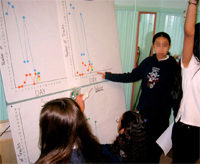Classroom Space, Classroom Time, and the Representation of Dynamic Phenomena
April 9th, 2007
Categories: Applications, Education, Human Factors, Visualization

Authors
Moher, T., Wiley, J.About
Over the past three years, we have defined and begun to explore the affordances of a design framework that we call Embedded Phenomena, intended to support such “patient,” extended classroom investigations.
The design space of the embedded phenomena framework is characterized by four common elements:
- Simulated dynamic scientific phenomena are “mapped onto,” and asserted to occur within, the physical space of the classroom.
- The phenomena are represented through distributed media (conventional classroom computers) located around the classroom representing “portals” into that phenomenon, depicting local state information and control affordances corresponding to the mapping between the room and the phenomenon. (Embedded phenomena are “delivered” using our “Phenomenon Server,” a web portal that supports configuration and scheduling of the simulation for delivery to any Internet-connected computer running a conventional web browser with a Flash plug-in.)
- The simulations are persistent, running and being presented continuously over extended time periods, concurrently but asynchronously with respect to the regular instructional flow.
- As individuals, in small groups, and as whole classes, students monitor and manipulate the state of the simulation through those media, gathering evidence to solve a problem or answer a question.
The framework “embeds” learning in both space and time. Learners are spatially embedded by situating their activity (and their representations of accumulating evidence) physically within the phenomenon under investigation.
Learners are temporally embedded within the time course determined by the simulation of the phenomenon itself, rather than the time course of classroom instruction. This “here and now” approach embodied by the embedded phenomena framework stands in contrast to the “there and then” nature of much of traditional science instruction.
The central conjecture underlying this work is that this dual embedding, within the context of appropriate instructional designs, can have beneficial impacts on cognitive and affective learner outcomes.
We have designed and implemented three illustrative systems and deployed them in over a dozen elementary school classrooms within the context of instructional units on seismology, insect ecology, and astronomy.
In a series of empirical studies, we have presented preliminary support for the conjecture that the embedded phenomena framework can positively impact individual learner outcomes in the development of skill in science practice, conceptual learning, and the development of stances as legitimized investigators.
In the discussion that follows, we will briefly describe the outcomes of those studies. But the primary goal of this paper is to introduce the concept of embedded phenomena to the AERA community and to make the case for the embedded phenomena framework as a paradigm worthy of further exploration.
Resources
URL
Citation
Moher, T., Wiley, J., Classroom Space, Classroom Time, and the Representation of Dynamic Phenomena, Paper presented at the Annual Conference of the American Educational Research Association, Chicago, IL, April 9th, 2007. http://www.aera.net/meetings/Default.aspx?menu_id=24&id=282